|
- Catalog (in stock)
- Back-Catalog
- Mail Order
- Online Order
- Sounds
- Instruments
- Projects
- History Face
- ten years 87-97
- Review Face
- our friends
- Albis Face
- Albis - Photos
- Albis Work
- Links
- Home
- Contact
- Profil YouTube
- Overton Network
P & C December 1998
- Face Music / Albi
- last update 03-2016
|
1. Oy ty, vyshen'ko - Cherkasy region - 3:02
2. Da zelen yavor - Polyssia region - 5:33
3. Oy letila halka - Poltava region - 4:53
4. Oy na hori na vysokiy - Central Ukraine - 2:57
5. Oy hylya, hylya - Central Ukraine - 4:24
6. Tak vono buvaye - Central Ukraine - 3:39
7. Oy khmarka nadkhodyt - Cherkasy region - 2:41
8. Oy po lanu - Poltava region - 4:10
9. V subotu piznenko - Kiev region - 1:58
10. A shche sontse ne zakhodylo - Central Ukraine - 2:08
11. Marusyu - Kiev region - 4:22
12. A ya vchora v kumy - Kiev region - 2:01
13. Kotylasya ta yasna zorya - Central Ukraine - 3:06
14. Osin moya dovhaya - Kiev region - 4:26
15. Oy ishly dva kozaky - Central Ukraine - 5:57
16. Shcho zh to vono za verba - Cherkasy region - 2:22
17. Oy ziydy, ziydy - Central Ukraine - 3:10
18. Tuman yarom - Central Ukraine - 3:22
|
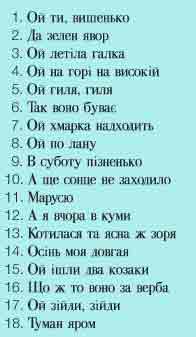 |
The ensemble Khreshchaty Yar was founded in June 1990. All its members have studied either at the conservatory or at the music academy in Kiev and are now musicians by profession.
The name of the ensemble can be explained in two ways
|
- Yar = "gorge, ravine" and Khreshenye = "baptism". There is a main street in Kiev with this name and it is said that in 988 AD, prince Volodymyr led his people on this road (at that time it was a country road) to the river Dnepr for baptism. |
|
- The second explanation derives from an archaic meaning of the two words: Khreshaty = "to be reborn again and again, having reached immortality"; Yar or Yarylo meant "Sun God". Thus, the two words combined stand for the "eternal, immortal or everlasting sun". |
Songs
The songs presented on this CD belong to various categories.
|
- The songs 1, 4, 5, 7, 11, 13, 17 and 18 belong to a category we can call evening songs or winter evening songs. In Ukrainian they are called vechornyzi (vechyr = evening). This word is not only used for the songs, but it also stands for the young people's evening meetings as well as for the room, where they take place. Vechornyzi are only sung in the winter period beginning with the 13th of December, the Holy Andrijs Day, and lasting until 7 weeks before Eastern with the start of Lent. During this period, young people in the country meet almost every evening after the daily work. They rent a room for their vechornyzi meetings, preferably in the house of a widow or a childless married couple. The girls arrive first and start embroidering shirts (rushnyc). Later, the young men (lads) join them and they dance and sing together. They don't have to pay with money for the rented room, but they bring bread, cereals or linen. Only the drinks at the bar have to be paid in cash. |
|
- The songs 3, 6, 8, 10 and 14 are called toloka. They are sung during or after joint work. In winter, when women meet for spinning, they accompany their work singing toloka. This kind of songs is also sung in the other seasons after all kinds of team work (e.g. field work, digging for a well, building a house, repairing streets, etc.). When a farmer has a lot of work in the fields, he asks his neighbours for help. After having finished this common work, the farmer invites his neighbours for dinner and then they sing such songs with lyrics that often contain some worldly wisdom |
|
- The songs 12 and 16 are so-called table or dining songs. Song 16 is a typical Cossack table song.
There are two more song categories in this collection worth mentioning, each of them presented with one example. Song 9 belongs to the genre of soldiers' songs, here also called recruits' songs, because it is always sung, when a young man enlists for military service. Song 15 is a ballad, which is sometimes also sung on the marketplace with the accompaniment of the kobza or the bandura. |
|
- Not all songs belong to a specific genre or have a particular function. They can be sung at any moment, when somebody feels like singing. This is the case for song 2 in this collection |
1. Oy ty, vyshen'ko - Cherkasy region
- Anatoliy Kurylo (precentor), Valentyna Bogdanova (high register), Volodymyr Biletsky, Ivan Volynets, Volodymyr Budz
|
- A cherry tree grows on the riverside of the Don. It embodies the soul of a young girl, who is sad, because she hasn't found her beloved one.
|
2. Da zelen yavor - Polyssia region
- Anatoliy Kurylo (precentor), Valentyna Bogdanova (high register), Volodymyr Biletsky, Ivan Volynets, Volodymyr Budz
|
- A Cossack, who didn't come back home, because he had been killed in action
|
3. Oy letila halka - Poltava region
- Anatoliy Kurylo (precentor), Valentyna Bogdanova (high register), Volodymyr Biletsky, Ivan Volynets, Volodymyr Budz
|
- A young, wise girl has been waiting for her brother's homecoming. She has been waiting for ten years. During a conversation, her brother tells her that he doesn't feel well. He says that it he feels as if a snake was sneaking around his heart. His sister replies: "If this is an illness, the medicine will help you, if it is love nothing can help you and you are finished."
|
4. Oy na hori na vysokiy - Central Ukraine
- Anatoliy Kurylo (precentor), Valentyna Bogdanova (high register), Volodymyr Biletsky, Ivan Volynets, Volodymyr Budz
|
- A Cossack leaves his girl-friend saying: "I am going to look for a better girl". Later, he returns to her and says: "I have been looking all around in all the villages and cities, but I didn't find any better girl than you."
|
5. Oy hylya, hylya - Central Ukraine
- Anatoliy Kurylo, Valentyna Bogdanova (high register), Volodymyr Biletsky (precentor), Ivan Volynets, Volodymyr Budz
|
- A young man visits a young girl and asks her for dinner. The girl replies to him: "I have already prepared dinner, but not for you."
|
6. Tak vono buvaye - Central Ukraine
- Anatoliy Kurylo (precentor), Valentyna Bogdanova (high register), Volodymyr Biletsky, Ivan Volynets, Volodymyr Budz
|
- When a woman stays with a good man, that takes years off her age. Such a man neither scolds her, nor does he hit her. He always calls her his lovely dove.
|
7. Oy khmarka nadkhodyt - Cherkasy region
- Anatoliy Kurylo (precentor), Valentyna Bogdanova (high register), Volodymyr Biletsky, Ivan Volynets, Volodymyr Budz
|
- A young man is asking advice from his girl-friend: "Tell me, shall I marry you or shall I wait for you?" The girls replies: "Yes please, do marry me. It is the right time as I am still young and I want to get my freedom."
|
8. Oy po lanu - Poltava region
- Anatoliy Kurylo (precentor), Valentyna Bogdanova (high register), Volodymyr Biletsky, Ivan Volynets, Volodymyr Budz
|
- The Cossacks ask a widow for an overnight stay and fodder for the horses. The widow replies: "I didn't make hey, yet. 18 years ago, my husband went for military service and left me alone with my child."
|
9. V subotu piznenko - Kiev region
- Anatoliy Kurylo (precentor), Valentyna Bogdanova (high register), Volodymyr Biletsky, Ivan Volynets, Volodymyr Budz
|
- A mother accompanies her son, when he is leaving for military service, and she asks him: "Who is going to look after your girl-friend?" He replies: "If my friend returns from military service, he will provide for my beloved one."
|
10. A shche sontse ne zakhodylo - Central Ukraine
- Anatoliy Kurylo (precentor), Valentyna Bogdanova (high register), Volodymyr Biletsky, Ivan Volynets, Volodymyr Budz
|
- The young girl, who loves a Cossack, is unhappy. The Cossack goes abroad and the girl remains all alone at home. I don't want to remain a girl nor become a widow, but a "pokrytka". (Pokrytka is the term for a girl, who has a child without being married).
|
11. Marusyu - Kiev region
- Anatoliy Kurylo (precentor), Valentyna Bogdanova (high register), Volodymyr Bilezky, Ivan Volynets, Volodymyr Budz
|
In the Ukraine existed a tradition. When an orphan-girl wanted to marry, she could ask her bridegroom's parents for their consent, and they were not allowed to refuse it, because she was an orphan.
|
- A girl went to see her fiancé's mother and said to her: "I want to marry your son". The mother replied: "I am not going to admit this. Leave my son alone. I give you money instead." The girl replied: "I don't want your money, I am in love with your son."
|
12. A ya vchora v kumy - Kiev region
- Anatoliy Kurylo (precentor), Valentyna Bogdanova (high register), Volodymyr Biletsky, Ivan Volynets, Volodymyr Budz
|
- "My good-mother is coming to see me tomorrow. In order to entertain her, I am going to catch a sparrow and I will serve her sausage, jellied meat and bacon. Like this, we are going to have a fine meal."
|
13. Kotylasya ta yasna zorya - Central Ukraine
- Anatoliy Kurylo, Valentyna Bogdanova (high register), Volodymyr Biletsky, Ivan Volynets (precentor), Volodymyr Budz
|
- Love song - A young girl is asking: "Who is going to take me home?" A Cossack, who has heard her say so, offers to accompany her home.
|
14. Osin moya dovhaya - Kiev region
- Anatoliy Kurylo (precentor), Valentyna Bogdanova (high register), Volodymyr Biletsky, Ivan Volynets, Volodymyr Budz
|
- A young woman is sad, because her lover is not with her at home. "Who shall I dinner with? My lover is at the Don and I am going there now to look for him." She searched for him all along the River Don, but could not find him. In one valley though, she found the grave of her lover.
|
15. Oy ishly dva kozaky - Central Ukraine
- Anatoliy Kurylo (high register), Valentyna Bogdanova, Volodymyr Biletsky (precentor), Ivan Volynets, Volodymyr Budz
|
- Ballad - Two Cossacks while taking a rest. By kindling a fire they burned the nest of a nightingale. The nightingale flies to the cuckoo and complains: "Brother, my children have been killed". The cuckoo replies: "I have always been telling you not to build your nest in the meadow, but in the rocks or on a high tree".
|
16. Shcho zh to vono za verba - Cherkasy region
- Anatoliy Kurylo (high register), Valentyna Bogdanova, Volodymyr Biletsky, Ivan Volynets (precentor), Volodymyr Budz
|
- A widow is flirting with a Cossack. However, he says: "We are going to war and we don't take women with us."
|
17. Oy ziydy, ziydy - Central Ukraine
- Anatoliy Kurylo (precentor), Valentyna Bogdanova (high register), Volodymyr Biletsky, Ivan Volynets, Volodymyr Budz
|
- Love song - A young girls is going on a walk with a young man, even though her mother had not given her consent.
|
18. Tuman yarom - Central Ukraine
- Anatoliy Kurylo (precentor), Valentyna Bogdanova (high register), Volodymyr Biletsky, Ivan Volynets, Volodymyr Budz
|
- A young girl wanted to get water from the well. Then the bucket fell into the well. So the girls asks: "Who is going to get the bucket out of the well for me? For doing that he can marry me."
|
Traditional Music from the Ukraine
Traditional Ukrainian music is predominantly heterephonic: the same melody is distributed among different voice parts, with one leading voice, mostly in a middle register. The lead singer (zaspivoovach) determines the course of the melody and the other voices come in later. This heterophonic group singing is often embellished by an independent voice in a very high register (vyvodtshyk).
The principle of heterophony allows the principal voice much space for improvisation, continuous variation and embellishment. It has also an effect on the lyrics, in so far as single words or phrases are lengthened with vocalisms or enlarged with additional syllables.
There is a rich repertory of many famous Cossack songs and dance traditions. This music has its roots in a centuries old oral tradition of bylina (epics, heroic narrative poetry) and dumas, that is long lyrical ballads glorifying the exploits of the Cossacks.
- more information Traditional Music and Instruments from the Ukraine
The Ukraine
The present-day Ukraine is a state in the size of France with over 50 million inhabitants. Wide parts belong to the eastern European lowland. Big rivers like the Volga, the Don, the Dnepr and the Dniester flow through this land and some of them into the Black Sea. Quite early, they became very important trade routes to the North and to Central Europe. In the Ukraine, there are no natural borders except the Carpathian mountains in the west and the Prypjat marshland in the northwest, which were areas of both frequent military conflict and cultural transmission. The word Ukraine means border area, and as the history shows, the area came under the influence of different cultural areas and reigns. On the edge of the steppes north of the Black Sea, the borders between the sedentary societies of the Christian Slavs and the nomadic tribes of Islamic Tartars were fluid. Later, north-western and central Ukraine became an arena of expansion for a new power that had arisen in the 13th century, the grand duchy of Lithuania. Then the greater part of the Ukrainian territories was detached from Lithuania and annexed directly to the kingdom of Poland. Then followed the Russian empire, the Habsburg empire and, in the 20th Century again Poland and the Soviet Union.
The Ukraine was only autonomous during the Kievan empire (Kievan Rus) from the 10th till the 13th century, then as the principality Galicia-Volhynia in the 13th and 14th centuries, as the Hetmanate (hetman or ataman = commander in chief) of the Dnepr Cossacks in the 17th century and in 1918, and finally from 1918 to 1920 as the Ukrainian People's Republic.
- map sketch Historical map of the Ukraine
History
The Black Sea coast was for centuries in the sphere of contemporary Mediterranean powers. Beginning in the 7th - 6th centuries BC, numerous Greek colonies were founded on the coast of the Black Sea, in the Crimea and along the Sea of Azov. Later, they came under the Roman Empire.
During the 1st millennium BC, the open steppe was occupied successively by the Cimmerians, the Scythians and the Sarmatians, all nomadic peoples of Iranian stock. In several successive waves, nomadic horseman from Central Asia used this natural gateway (the hinterland steppes) to invade Europe.
The mixed forest-steppe and the forest belt, linked by waterways to northern and central Europe, became the homeland of a sedentary agricultural population. Under the impact of Germanic migrations in the 5th and the 6th centuries, Slavic tribes moved from their primordial homeland north of the Carpathians. The East Slavs occupied the forest and the forest-steppe region in today's western and north-central Ukraine. Then they expanded further to southern Belarus and to the northeast into territories of the future Russian state centred on Moscow. The East Slavs practiced agriculture and animal husbandry and became engaged in domestic industries such as cloth making and ceramics. They built fortified settlements like Kiev on the right bank of the Dnepr River.
A period of great migrations began with the descent of the Goths from the Baltic region about AD 200. They displaced the Sarmatians, but their own power was broken about 375 by the invading Huns from the east, who were followed in the 5th - 6th centuries by the Bulgars and Avars. Between the 7th and 9th centuries, the Ukrainian steppe formed part of the Turkic Khazar kaganate, a mercantile empire centred on the lower Volga River (Novogorod). In the late 9th century followed the Magyars (Hungarians) and in the 10th and the 11th century the Pechenegs and Cumans (nomadic Turkic people). The Cumans stayed until the Mongol Invasion in 1237.
The first people, who controlled the area for a longer period (from AD 882 until the late 10th century), were the Varangians (Norsemen) known as the Rus. They were a people of merchants and warriors, who controlled the trade along the Dnepr route from the Baltic to Byzantium, on which Kiev was strategically sited. From their ranks came the progenitors of the Kievan princes. The so-called Kievan Rus lived in an area stretching from the Baltic to the Volga in the West and the Danube in the South. Kiev reached its apogee in the reigns of Volodymyr the Great, who adopted Christianity as the religion of his realm. The patriarch of Constantinople appointed a metropolitan in Kiev and so Kievan Rus entered the orbit of Byzantine influence that lasted for a long period. By 1520 though, the whole coast of the Black Sea was controlled by the Ottoman Empire.
The Cossacks
The Cossackdom is one of the most original and significant appearances of Russian history. In the 16th century, Cossack communities developed in the southern area, in the region of Moscow, in Belarus and the Ukraine. They accomplished a great deal for Russia with their colonization of conquered territories and the defence of the same. They also influenced the state's interior law-and-order and the historical evolution of the country.
Sometimes, the Cossacks are considered to be the direct descendants of Non-Slavic tribes (Khazars, Cossogens, Tcherkesses, a.o.), who settled in some of the areas of southern Russia in the period of the disintegration. This conclusion is only based on the origin of the word "Cossack" (from the Turkic kazak, or "free man", also meaning outlaw, adventurer or freebooter). The Tartars hereby described a minor armed force division or single horsemen or any armed units that were independent from the Khan (the commander of the Tartars). Ethnically though, the Cossacks are Ukrainians, despite their name. The Cossackdom, a new martial society, was beginning to evolve in Ukraine's southern steppe frontier in the 15th century. The Cossacks developed a military organization of a peculiarly democratic kind, with a general assembly as the supreme authority and elected officers, including the commander in chief, or hetman. Thus, they were able to protect the borderlines against the constant danger of attacks by the Tartar's Golden Hordes with war strategies the Polish-Lithuanian states were lacking.
The Cossacks didn't only defend Ukraine's frontiers population from Tartar incursions, but conducted their own campaigns into Crimean territory and, in their flotillas of light craft, even raided Turkish coastal cities in Anatolia. The Polish government found the Cossacks a useful fighting force in wars with the Tartars, Turks and Muscovites, but in peacetime viewed them as a dangerously volatile element. Attempts to control them institutionally created serious discontent among the Cossacks, who increasingly perceived themselves as forming a distinct estate with inherent rights and liberties. Sporadically over a half century, starting in 1591, the Cossacks rose up in revolts that were put down only with great difficulty.
The structures of all ancient Cossack communities were equal. The Don-Cossacks lived in family-like reinforced settlements on the river Don and its tributaries Medveditsa, Khoper, Donets and Sherebets. The property of land was of common ownership. Apart from their military campaigns they pursued, most of all, fishing and hunting. When they started to cultivate the fields in the Don area in the 17th century, the Supreme Command decided to interdict any such cultivation on penalty. The grain supplies were partly distributed by the government, partly acquired by trading in fish as well as Turkish and Tartar merchandise with the inhabitants of the Russian neighbourhood areas.
The administration of the troupes was in the hands of the ataman or hetman (commander in chief), who, like his assistant, the yessaul (captain) and one official military writer, who was responsible for the correspondence, were elected by the Cossacks' Common Legislative Assembly, (krug, literally "circle"), and could be removed from office at any time. All significant questions were decided by the assembly. The Hetman and his assistant were only the executors of the intentions of the assembly. Among the mutual responsibilities of the Hetman and the assembly were all affairs of the armed forces as well as court procedures. Severe crimes, especially political ones, were sentenced with death penalty by drowning, officially described as "setting into the water". Within all Cossack settlements, a proper supreme assembly was elected, and the chosen eldest were responsible for the interior affairs of the community.
During military campaigns, these democratic institutions were replaced by the hetman s despotic rules. But he was obliged to give a report upon his activities during a battle, after returning home.
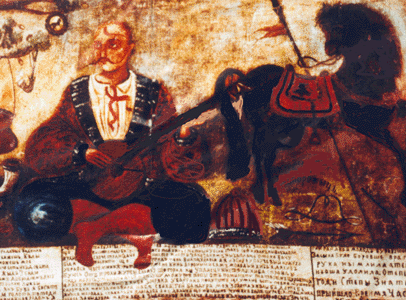
You can find more information about traditional songs of the Cossacks in the albums with the Ensemble Pesnokhorki from Barnaul, Siberia / Russia - Face Music: FM 50017 and FM 50019.
Language and Religion
The Ukrainian language belongs, like Russian and Belo Russian, to the family of the East Slavic languages. Written documents only exist since Christianity had been adopted and Kiev had become the first Christian centre in the eastern Slavic area in AD 998. The oldest documents are transcriptions of church texts, which in the 9th century, the Slavic apostles Kyrill and Method had transcribed into the south Slavic dialect of the Thessalonica area. They created for this purpose an alphabet similar to Greek and called it Kyrilliza. These texts, also known as old Bulgarian or old Slavonic texts, are the basis of the current Church language of all orthodox Slavs, Bulgarians, Serbs, Russians, Ukrainians etc.. Thanks to the political separation from Northern Russia and the affiliation to the Lithuanian grand duchy and later to the kingdom of Poland, Ukrainian appears as a language of its own in the 14th century.
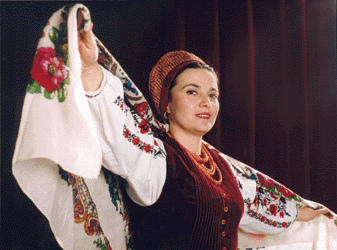
Valentyna Bogdanova: soprano
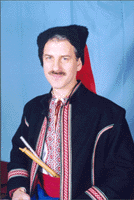 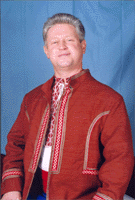  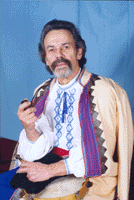
Volodymyr Budz: baritone, Anatoliy Kurylo: tenor, Ivan Volynets: tenor, Volodymyr Biletsky: bass
Embroideries in the Ukraine
Among the folk crafts, embroideries are rated high in the Ukraine like everywhere in Russia. They are considered to reflect the beauty and fantasy of this world. They depict motifs from nature like trees and animals or other forms and beings of our world as well as mythological themes. There are also ornaments in relation with Ukrainian traditions and customs. The embroideries from the Poltava region on the middle course of the Dnepr are famous for their pastel colours. Those from the Chernigiev region have red and black dots. Kievan embroideries are distinct by their contrast combination of red and black. Those from Podolia have extravagant patterns.
The ornaments on the towels and the shirts (Ukrainian = rushnyc) are of a symbolic meaning that is part of the peasants' entire life.
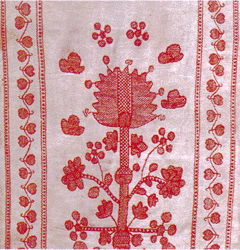 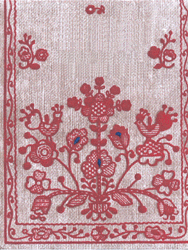
Emproidery pattern from the Poltava region - Ukraine
Translations: Silvia Delorenzi-SchenkeL
Many thanks for helping to the good souls Thomas Häusermann, Zimi and Vitalij Vosnjak
|
|
|
|
